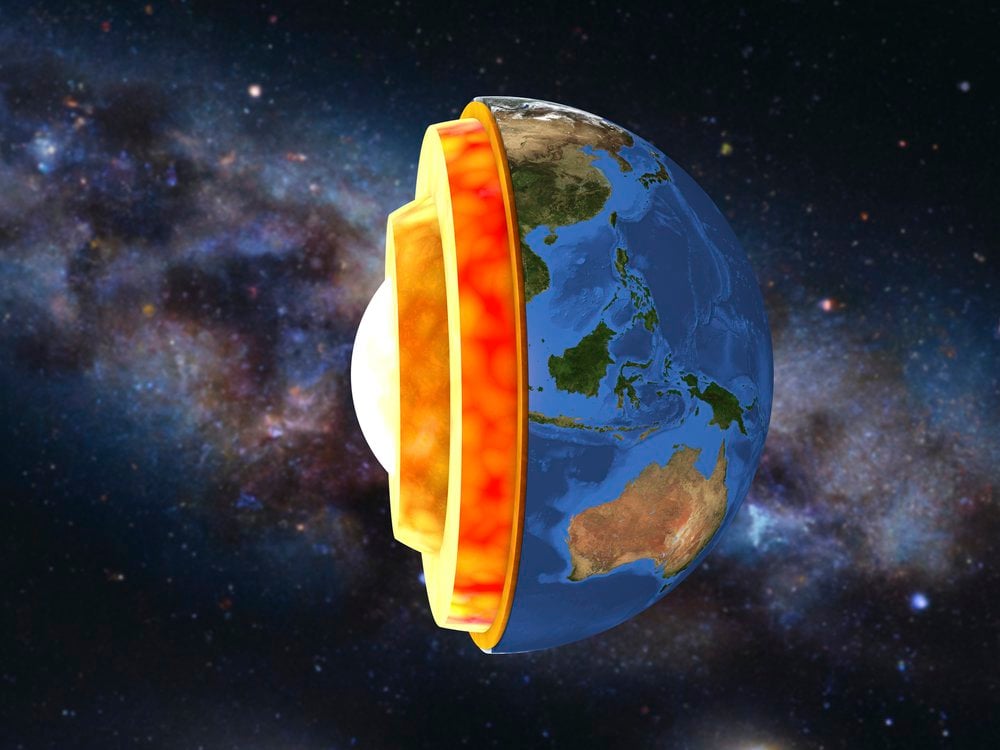Scientists Find Evidence of Another Core Within Earth’s Center
The newly proposed layer might have a different structure from the rest of the inner core

By studying seismic waves from earthquakes, scientists have detected evidence of another core at the center of the Earth. They call this new layer, located at the heart of Earth’s inner core, the “innermost inner core.”
As seismic waves pass through this region, their speed changes, according to a new paper published last week in the journal Nature Communications. This observed shift signals that something is different about the innermost orb’s texture or structure.
Earth’s inner core, a 1,500-mile-wide hot ball of metal, is still mysterious to scientists. Separated from the planet’s surface by thousands of miles of rock, it’s incredibly difficult to study.
“We may know more about the surface of other, distant celestial bodies than the deep interior of our planet,” first author Thanh-Son Pham, a seismologist at the Australian National University, tells Reuters’ Will Dunham.
But by using seismic waves that plunge deep into the Earth, scientists are learning more about its center. In 2002, researchers first suggested that the heart of our planet might have another layer inside of it based on observations of these waves, writes the New York Times’ Kenneth Chang.
At that time, though, scientists only had sparse data available. To pick up a seismic wave carrying data from the Earth’s core, they needed sensors positioned on the opposite side of the planet from the earthquake—and such locations are often in the middle of the ocean, write the paper’s authors in the Conversation.
With this new paper, the researchers were able to observe the reflections of waves, which bounced from the other side of the Earth and rebounded back toward the earthquake’s epicenter. More seismic sensors have been installed in recent years, and combining their power allows researchers to detect the weak signals of these rebounding waves. Some waves passed through the inner core as many as five times as they reverberated repeatedly through the planet. Depending on the direction of the waves, their speed changed as they passed through the innermost inner core, writes the Washington Post’s Kasha Patel.
“We strengthen existing evidence for the existence of the innermost inner core,” Pham tells Scientific American’s Stephanie Pappas.
The two proposed layers of Earth’s inner core appear to be similar—both are composed of an iron-nickel alloy—but they sport different crystal structures, per the Post. The transition between the inner and innermost cores seems gradual, Pham tells Reuters.
But Dan Frost, a seismologist at the University of South Carolina who did not contribute to the study, tells Scientific American that the results might not be evidence of a distinct transition. “I think it is an unnecessary splitting into multiple layers,” he says to the publication.
Researchers study the Earth’s core in part because it has influenced the development of life on the planet’s surface. The inner core’s intense heat causes a convection current in the liquid outer core, which creates Earth’s magnetic field. This magnetic field protects us and other life from cosmic radiation. The team’s findings might help explain how the magnetic field formed, per the Post.
“Kudos to them for uncovering the observations that further studies might use to unravel the perplexities of the inner core’s structure,” George Helffrich, a seismologist at the Tokyo Institute of Technology in Japan who did not contribute to the paper, tells the Times.

